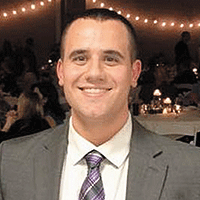They’re the rarest of the rare: bleeding disorders like platelet storage pool disorder and factor XIII deficiency that affect only a miniscule percentage of the population. Getting to a diagnosis can be challenging enough, when most doctors have never seen a case. What’s more, treatments are often a work in progress. Managing the condition often entails trial and error.
But challenges can create opportunities, as they have for these four people. Not only are they leading full lives with rare bleeding disorders, but they’re also a testament to the strides being made in disease management, as it’s happening, one person at a time.
Josh Beck
The Educator
Josh Beck, 35, is a born educator. He teaches English at Cudahy High School in Wisconsin, but has been educating people about his bleeding disorder for two decades now. Beck was born with factor XI (FXI) deficiency, also known as hemophilia C, although he didn’t know it until he was 14. It didn’t take Beck long to realize that the more he and those close to him knew about the condition, the easier it would be to live with a bleeding disorder.
When Beck was a sophomore in college, his wisdom teeth were removed. But the oral surgeon didn’t believe he had FXI deficiency, so he didn’t give Beck the necessary pre-treatment with fresh frozen plasma. A week later, Beck was in the hospital, hemorrhaging from the surgery. “That was what spurred me to think, ‘If they’re not going to believe me, listen to me or take the initiative to talk to the other doctors, there must be other professionals out there who will actually listen to their patients,’” he says.

Josh Beck (pictured above with sister
Angela Mesich) takes a proactive
approach to preventing nosebleeds
and other issues.
Since then, Beck has chosen his doctors carefully. He recently started with a new internist, and educated him about how his condition affects him. Beck was pleased when the doctor asked about resources his previous internist had used, so he could use them, too. His immunologist is just as collaborative. She worked with Beck’s hematologist to help him better manage his asthma so he can take less medication, which dries out his sinuses and causes nosebleeds. “My hematologist thinks my getting off some of my asthma medications is part of the reason I haven’t had as many bleeding episodes lately,” Beck says.
By working with his doctors and researching his condition, Beck has found other preventive strategies. These include using home humidifiers and saline spray to keep his nasal passages moist, especially during the cold, dry winter months. These measures haven’t eliminated his nosebleeds, but they’re far less frequent. “I’ve become more aware of what I can do to prevent as many issues as possible,” Beck says. For instance, he avoids products and beverages that increase bleeding risk, such as aspirin, ibuprofen and alcohol.
In case of an emergency, Beck uses Stimate® nasal spray, a medication that activates factor VIII, which he says some research shows also activates factor XI. If it doesn’t work—or if his injury is serious—those around Beck know to get him to the ER.
Beck’s love of teaching reaches beyond the classroom walls. “Helping people become aware that there are rare conditions out there is one of the biggest successes I’ve had living with hemophilia C,” Beck says. Among those are his students. “It teaches them that some people have health conditions they can’t see.”
Focus on Four: Rare Bleeding Disorders Detailed
Factor XI (FXI) deficiency
Also called hemophilia C, plasma thromboplastin antecedent deficiency and Rosenthal syndrome, FXI deficiency occurs in an estimated 1 in 100,000 people in the general population. FXI deficiency is inherited in anautosomal recessive pattern, meaning both parents must carry the gene to pass it on to their children. It affects men and women equally. People of Ashkenazi Jewish heritage are at higher risk.
Learn more about FXI deficiency at www.hemaware.org/bleeding-disorders-z/factor-xi-deficiency-facts.
Kari Peepe
The Activist

Kari Peepe (with daughter Scarlett)
was diagnosed at age 32.
All her life, Kari Peepe, 37, has known something was wrong with her health. Despite growing up prone to easy bruising and heavy nosebleeds, doctors couldn’t arrive at a diagnosis. She was tested for hemophilia in the 1980s and 1990s, but her blood tests always came back normal. When she bled profusely after the birth of her first child, her doctors still didn’t take her symptoms seriously.
It wasn’t until 2011, at age 32, that Peepe and her daughter Scarlett were diagnosed with platelet storage pool disorder. It took a phone call to social services from a concerned citizen who was alarmed seeing a mother and daughter with so many bruises to start the process that led to the diagnosis.
“In a way, it was a blessing because it finally pushed everybody to recognize that something was going on,” Peepe says. The preschool teacher/director lives in Rohnert Park, California, with her husband and two children: Scarlett, now 7, and son, Walker, 3, who does not have the disorder.
After the diagnosis, Peepe began looking for other people with the same condition. However, searching multiple online groups turned up fewer than 20 families worldwide. What’s more, there’s no agreement among experts about whether it should be called a disorder, deficiency, defect or disease. “That’s one of the things I’m fighting for,” Peepe explains. “Plus, we’re all grouped together even though we’re not all deficient in the same part of the platelet.”

Kari Peepe (far right) with her family.
She launched a blog to promote
awareness and education.
Although platelet storage pool disorder is becoming more recognized and accepted as part of the larger bleeding disorders community, Peepe says there’s still a lack of knowledge and support compared with people with more common disorders, such as hemophilia and von Willebrand disease. That’s one reason she is committed to building an online community, including an informational website. Peepe’s is the only one she’s aware of that focuses exclusively on platelet storage pool disorder. (See “Learn More” at bottom of page.) “It’s been neat to see the community grow and get more recognized over the past two years since I started making some noise,” says Peepe.
Focus on Four: Rare Bleeding Disorders Detailed
Platelet storage pool disorders
Platelet storage pool disorders (or deficiencies) are caused by problems with the platelet granules, tiny storage sacs within the platelets that release various substances to help stop bleeding. They result when platelet granules are missing, not enough are produced or they can’t empty their contents into the bloodstream.
Mark Stewart
The Advocate

Mark Stewart
Over the years, Mark Stewart, of Columbus, Ohio, has learned to advocate for himself. He has to, given that he has the rarest factor disorder: factor XIII (FXIII), or fibrin stabilizing factor, deficiency. FXIII deficiency only affects about 1,000 people worldwide. Although Stewart’s older brother and sister have FXIII deficiency, he’s not likely to meet many other people—including doctors—who have even heard of his condition.
“When a doctor I’ve never met tells me he’s treated it, let alone in a particular situation, it’s a red flag,” says Stewart. That’s why he considers it a victory when he finds doctors who understand they need to educate themselves about FXIII deficiency, as the members of his regular care team have.
But that’s not to say there aren’t challenges for Stewart, 28, who works in shipping. Advocating on his own behalf with his health insurance company is his biggest obstacle right now. Stewart has FXIII A-subunit deficiency, and he takes Tretten® for routine prophylaxis. He gets his medication from a specialty pharmacy without a hassle, until the bills come. Stewart’s health insurance company has identified his condition as hemophilia, so it wants records of bleeding and frequent clinic visits that are typical of someone with hemophilia.
 But those aren’t issues for Stewart because he treats prophylactically. “It’s a constant struggle every month to explain that the records they have are my most current medical records, because I haven’t been to the doctor since then,” he says. Stewart got so frustrated repeating his story to someone new every time he called that he finally convinced a manager to assign him a dedicated contact in the billing department.
But those aren’t issues for Stewart because he treats prophylactically. “It’s a constant struggle every month to explain that the records they have are my most current medical records, because I haven’t been to the doctor since then,” he says. Stewart got so frustrated repeating his story to someone new every time he called that he finally convinced a manager to assign him a dedicated contact in the billing department.
Although it’s never been simple explaining life to anyone unfamiliar with the condition, Stewart continues to speak up for himself. “I’m always searching the Internet because every once in a while I’ll see a new article about factor XIII deficiency,” he says. “It’s something to show a new doctor in an emergency if I have to.”
Focus on Four: Rare Bleeding Disorders Detailed
Factor XIII (FXIII) deficiency
Also called fibrin stabilizing factor, FXIII deficiency is the rarest factor deficiency, occurring in 1 per 5 million births. Both parents must carry the gene to pass it on to their children. It affects men and women equally. FXIII deficiency can be harder to diagnose because people with the condition form a clot, so clotting tests come back
normal. FXIII assays and a clot solubility test are needed for a diagnosis.
Learn more about FXIII deficiency at www.hemaware.org/bleeding-disorders-z/factor-xiii-deficiency-one-rarest-bleeding-disorders.
Kali Woldt
The Optimist

Kali Woldt, pictured on vacation in
Florida, says the disorder has helped
her appreciate life.
Kali Woldt would never say living with Glanzmann thrombasthenia is easy. But even if she could start over, growing up without a bleeding disorder, she wouldn’t change her condition. “I’ve gotten to meet so many great people and experienced so many wonderful things,” says the 20-year-old college junior. “It’s really helped me grow as a person and appreciate life much more.”
Ever since she was diagnosed at age 3, Woldt hasn’t let her bleeding disorder slow her down. When her mother told her she couldn’t take up ice skating with her sister because it was too dangerous, Woldt started dance lessons instead. She stuck with it until she graduated from high school.
Early on, Woldt’s mother took her to conferences and summer camps for people with bleeding disorders. Woldt was the first girl to attend Camp Warren Jyrch, the bleeding disorders camp in Illinois. That’s where she first met other kids with bleeding disorders.
Woldt is active in the bleeding disorders community. She delivers speeches and shares her experiences at conferences, which she considers central to living well with a bleeding disorder.
Nosebleeds have stopped Woldt in her tracks for as long as eight hours. Last year she wound up in the hospital getting infusions for nosebleeds more often than she’d like when self-treatment didn’t work. But it’s not the bleeding that bothers her as much as missing class at University of Wisconsin-Stevens Point. She’s a dedicated student—especially now that she’s decided what she wants to do with her health promotion major. “I’m going to use my own experience to help people in the bleeding disorders community find ways to improve their health,” Woldt says.
Woldt hopes to intern at her hemophilia treatment center (HTC), even as she continues her studies and pursues other goals. In 2015, she completed her first half-marathon. “It’s such an amazing feeling being able to do something you never thought you’d be able to do,” she says.
Common Ground, Common Goals
These four people each have different bleeding disorders, but they have one thing in common: a positive attitude about facing their daily challenges. Plus, they’re not just looking out for themselves. As they discover new ways to live better with their conditions, they’re eager to share what they’ve learned with others. So although their conditions are rare, their goals are common: being accepted, included and understood.
Focus on Four: Rare Bleeding Disorders Detailed
Glanzmann thrombasthenia
Glanzmann thrombasthenia This platelet function disorder is caused by an abnormality in the genes for glycoproteins IIb/IIIa. In people with Glanzmann thrombasthenia, platelets do not stick to each other at the site of injury, making it difficult for a normal blood clot to form. Because it’s an autosomal recessive disorder, both parents must carry an abnormal gene to pass it on to their child, even if they don’t have the disorder. It affects men and women equally. About one in 1 million people worldwide have this disease.
Learn more about platelet disorders by visiting www.hemaware.org/bleeding-disorders-z/inherited-platelet-disorders.

